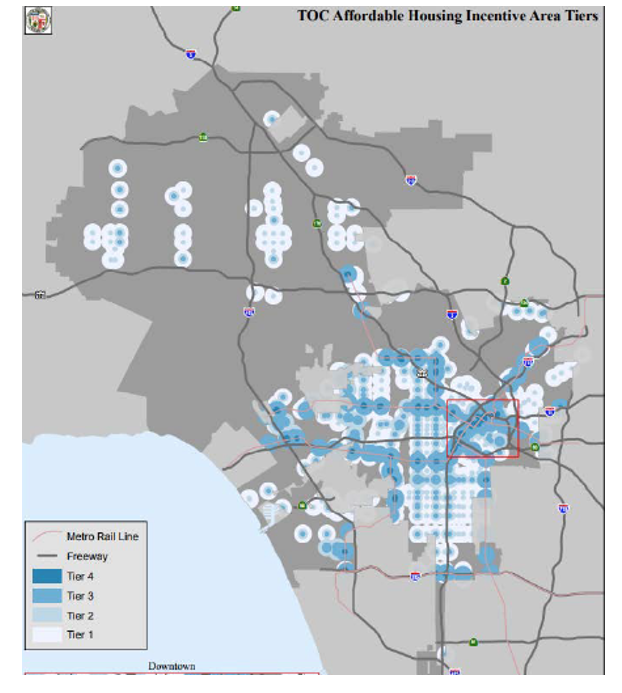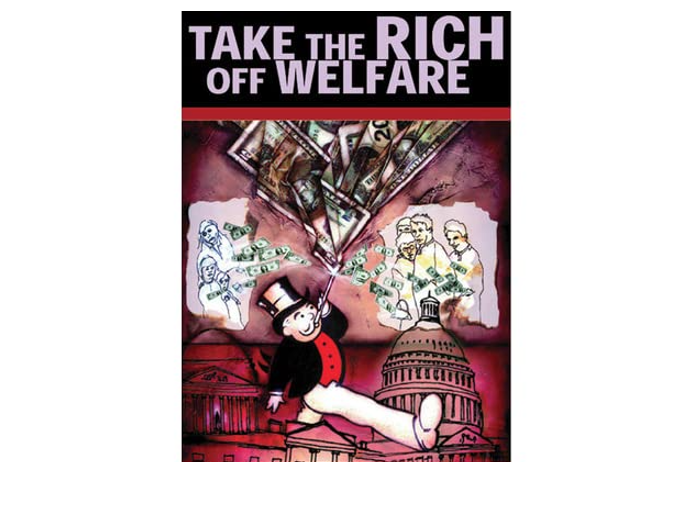CommentsPLANNING WATCH-While conservative presidents have railed against welfare queens, the biggest recipients of government generosity have been the well-off.
This was fully documented by Pro Publica, which this week published the first chapter of its wealthfare series, “The Secret IRS Files: Trove of Never-Before-Seen Records Reveal How the Wealthiest Avoid Income Tax.”
Wealthfare schemes take many forms, and one of the biggest local giveaways hides behind a benign name: Transit Oriented Community Guidelines density bonuses. For real estate speculators this Los Angeles program is the goose that lays their golden eggs. Like all forms of up-zoning, it not only raises the market value of their property, but it also allows them to legally dodge zoning laws restricting building height, size, and density.
In LA these density bonuses take two forms, and the density bonuses are either on-menu or off-menu?
-
Projects applying for a density bonus sanctioned by State Law SB 1818.
-
Projects that rely on the City of LA’s own Transit Oriented Community Guidelines (TOC).
Density bonuses began with California State Senate Bill 1818, adopted as a local Los Angeles ordinance in 2008. Los Angeles subsequently moved to a second type of density bonus, Transit Oriented Community (TOC) Guidelines. The TOC Guidelines implemented Measure JJJ, approved by Los Angeles voters in 2017. Measure JJJ was a last-minute ballot measure prepared by opponents of Measure S, the Neighborhood Integrity Ordinance, which appeared on the same ballot. The proponents of Measure JJJ claimed (incorrectly) that Measure S would block the construction of affordable housing. Measure S was defeated at the same time Measure JJJ passed, but the predicted monsoon of affordable housing never appeared. Instead, LA has witnessed growing homelessness and the construction of expensive luxury apartment buildings with high vacancy rates.
How Density Bonuses are supposed to address the housing crisis. In the case of the TOC Guidelines, on-menu density bonuses are automatically granted to developers whose projects fall into one of four tiers, based on their distance from transit stations and corridors. In exchange, they are required to include a small percentage of unverified affordable rental units in their projects.
As show on the map below, these four TOC tiers include most Los Angeles neighborhoods west, south, and east of the Downtown, plus major San Fernando Valley transit corridors.
The TOC on-menu density bonuses are ministerial (administrative) approvals exempt from the California Environmental Quality Act. They include substantial increases in a proposed project’s height, size (Floor Area Ratio), and density, as well as reductions in required on-site parking places. Like SB 1818 on-menu density bonuses, the TOC on-menu bonuses do not require notifications to nearby residents and property owners. Likewise, these on-menu approvals do not require environmental reviews, public hearings, votes by decision makers, determination letters, and rights of appeal.
The discretionary off-menu TOC density bonuses permit major reductions in setbacks, open space, lot coverage, lot width, plus major increases in density and height – with virtually no grounds for the to appeal a project.

How have Density Bonuses backfired? The simultaneous defeat of Measure S and victory of Measure JJJ priced an increasing number of Angelinos out of housing. If adopted, Measure S would have impeded the construction of some high-rise luxury apartment buildings, while Measure JJJ, reconstituted as the TOC Guidelines but only approved by the City Planning Commission, led to the construction of expensive apartment buildings. Although TOC projects are supposed to include affordable units, in practice they include few verified low-cost rental apartments occupied by vetted low-income tenants.
Why did the density bonus programs increase homelessness? In some cases, new TOC buildings replaced demolished low-income housing, and in all cases, the high rents of these new TOC buildings pulled up the rents in nearby older apartments. Since this happened in conjunction with increasing unemployment during the Covid 19 Pandemic, more people became homeless.
What are the lessons? Los Angeles does not suffer from a lack of available housing supply, but a lack of money among existing and potential renters rent these vacant units, including those in TOC buildings.
Furthermore, the voter-approved Measure JJJ and the TOC Guidelines are not the same. In support of its lawsuit challenging the TOC Guidelines, Fix the City says the TOC incentives “far exceed those authorized by the voters enacting Measure JJJ, while failing to provide for well-paid jobs adhering to the prevailing wage for Los Angeles.”
-
The TOC Guidelines include tiers, bonuses, and eligibility requirements that were not in the voter-approved Measure JJJ or in the truncated version of the TOC Ordinance folded into the Los Angeles Municipal Code as an ordinance. While the City Council can, of course, amend an ordinance, they never adopted the TOC Guidelines, even though a portion of the Guidelines can be found in Section 22.A.31 of the Los Angeles Municipal Code, linked to Ordinance 184,745 (the text of Measure JJJ).
-
The Fix the City lawsuit also contends that the TOC Guidelines conflict with the General Plan because they have NOT provided sufficient public infrastructure and services to adequately support the additional people and buildings that would result from TOC projects.
-
Measure JJJ also allows anyone to appeal an off-menu case, while the TOC Guidelines only grant the right of appeal to adjacent property owners and residents.
What else is wrong with the density bonuses programs?
-
There is no effective enforcement or monitoring of TOC projects. No City inspector ever visits a density bonus site to verify that the developer-pledged low-priced rental units exist or are leased to certified low-income tenants.
-
LA’s Housing and Community Investment Department (HCID) has not prepared easily accessible on-line data bases of certified tenants or available density bonus apartments.
-
Since on-menu density bonuses include ministerial changes in Floor Area Ratios, they undermine the City Charter by denying the City Council the authority to grant zone changes via changes to Height Districts.
If the Fix-the-City lawsuit against the City of Los Angeles is successful, and the local version of wealthfare in the form of TOC Guidelines is expunged, the public must be vigilant that this same scam does not resurface with new names, such as Community Plan Implementation Ordinances or Community Benefit Agreements appended to updated community plans.
(Dick Platkin is a former Los Angeles city planner who reports on local planning issues for CityWatch. He serves on the board of United Neighborhoods for Los Angeles (UN4LA) and co-chairs the new Greater Fairfax Residents Association. Previous Planning Watch columns are available at the CityWatchLA archives. Please send questions and corrections to [email protected].) Prepped for CityWatch by Linda Abrams.














